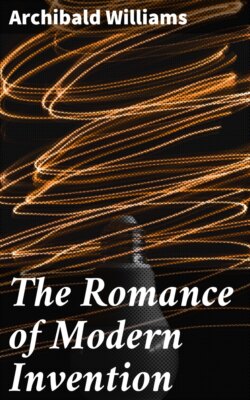Читать книгу The Romance of Modern Invention - Archibald Williams - Страница 9
На сайте Литреса книга снята с продажи.
THE PHONOGRAPH.
ОглавлениеTable of Contents
Even if Thomas Edison had not done wonders with electric lighting, telephones, electric torpedoes, new processes for separating iron from its ore, telegraphy, animated photography, and other things too numerous to mention, he would still have made for himself an enduring name as the inventor of the Phonograph. He has fitly been called the “Wizard of the West” from his genius for conjuring up out of what would appear to the multitude most unpromising materials startling scientific marvels, among which none is more truly wizard-like than the instrument that is as receptive of sound as the human ear, and of illimitable reproducing power. By virtue of its elfishly human characteristic, articulate speech, it occupies, and always will occupy, a very high position as a mechanical wonder. When listening to a telephone we are aware of the fact that the sounds are immediate reproductions of a living person’s voice, speaking at the moment and at a definite distance from us; but the phonographic utterances are those of a voice perhaps stilled for ever, and the difference adds romance to the speaking machine.
The Phonograph was born in 1876. As we may imagine, its appearance created a stir. A contributor to the Times wrote in 1877: “Not many weeks have passed since we were startled by the announcement that we could converse audibly with each other, although hundreds of miles apart, by means of so many miles of wire with a little electric magnet at each end.
“Another wonder is now promised us—an invention purely mechanical in its nature, by means of which words spoken by the human voice can be, so to speak, stored up and reproduced at will over and over again hundreds, it may be thousands, of times. What will be thought of a piece of mechanism by means of which a message of any length can be spoken on to a plate of metal—that plate sent by post to any part of the world and the message absolutely respoken in the very voice of the sender, purely by mechanical agency? What, too, shall be said of a mere machine, by means of which the old familiar voice of one who is no longer with us on earth can be heard speaking to us in the very tones and measure to which our ears were once accustomed?”
The first Edison machine was the climax of research in the realm of sound. As long ago as 1856 a Mr. Leo Scott made an instrument which received the formidable name of Phonautograph, on account of its capacity to register mechanically the vibrations set up in the atmosphere by the human voice or by musical instruments. A large metal cone like the mouth of an ear-trumpet had stretched across its smaller end a membrane, to which was attached a very delicate tracing-point working on the surface of a revolving cylinder covered with blackened paper. Any sound entering the trumpet agitated the membrane, which in turn moved the stylus and produced a line on the cylinder corresponding to the vibration. Scott’s apparatus could only record. It was, so to speak, the first half of the phonograph. Edison, twenty years later, added the active half. His machine, as briefly described in the Times, was simple; so very simple that many scientists must have wondered how they failed to invent it themselves.
A metal cylinder grooved with a continuous square-section thread of many turns to the inch was mounted horizontally on a long axle cut at one end with a screw-thread of the same “pitch” as that on the cylinder. The axle, working in upright supports, and furnished with a heavy flywheel to render the rate of revolution fairly uniform, was turned by a handle. Over the grooved cylinder was stretched a thin sheet of tinfoil, and on this rested lightly a steel tracing-point, mounted at the end of a spring and separated from a vibrating diaphragm by a small pad of rubber tubing. A large mouthpiece to concentrate sound on to the diaphragm completed the apparatus.
To make a record with this machine the cylinder was moved along until the tracing-point touched one extremity of the foil. The person speaking into the mouthpiece turned the handle to bring a fresh surface of foil continuously under the point, which, owing to the thread on the axle and the groove on the cylinder being of the same pitch, was always over the groove, and burnished the foil down into it to a greater or less depth according to the strength of the impulses received from the diaphragm.
